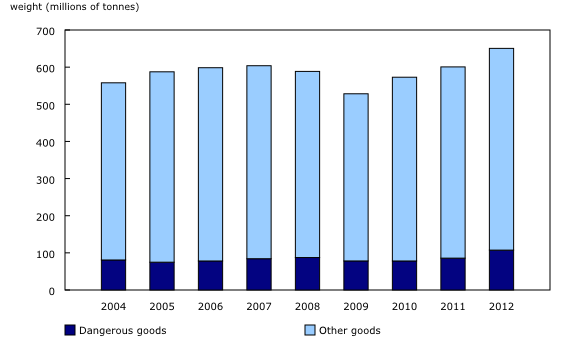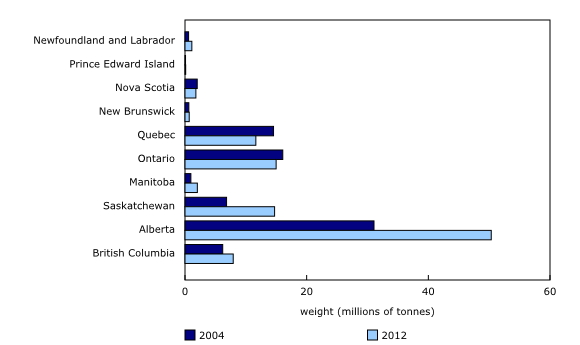Study: Trucking dangerous goods in Canada, 2004 to 2012
Archived Content
Information identified as archived is provided for reference, research or recordkeeping purposes. It is not subject to the Government of Canada Web Standards and has not been altered or updated since it was archived. Please "contact us" to request a format other than those available.
Released: 2015-02-11
In 2012, the combined weight of all commodities shipped by Canadian for-hire trucking establishments was over 650 million tonnes, with dangerous goods accounting for 17% of the total or about 107 million tonnes. This was an increase in the relative share of dangerous goods transported compared with the 81 million tonnes shipped in 2004, when dangerous goods made up 14% of total for-hire truck shipping.
An estimated four times as many tonnes of dangerous goods were moved by the for-hire trucking industry in 2012 as were transported by rail.
The quantity shipped is an important consideration in assessing the public safety and environmental risks of transporting dangerous goods; another is the type of commodity trucked.
Crude petroleum products accounted for the largest share of dangerous goods trucked in 2012 at more than one-third (38%), up from one-quarter (25%) in 2004. This was followed in 2012 by gasoline and aviation turbine fuel (24%), fuel oils (12%) and non-metallic minerals (5%).
Almost half of the total tonnage of dangerous goods trucked in 2012 originated in Alberta. The major contributor were shipments of crude petroleum products, which more than doubled from about 15 million tonnes in 2004 to over 30 million tonnes in 2012. In Saskatchewan, over the same period, higher shipments of crude petroleum products and other commodities, including fertilizers and fertilizer materials, combined to more than double the total tonnage of all dangerous goods trucked originating in the province.
In 2012, crude petroleum products were trucked an average distance of 110 kilometres compared with 313 kilometres for all other dangerous goods. As a result, the average distance all dangerous goods were trucked declined from 316 kilometres in 2004 to 269 kilometres in 2012.
Note to readers
This study examines dangerous goods transported by the Canadian for-hire trucking industry from 2004 to 2012. The study was based on data from the annual Trucking Commodity Origin Destination Survey. The for-hire trucking industry excludes foreign-based trucking establishments operating in Canada and non-trucking establishments with their own fleets (that is, private trucking).
The article "Trucking dangerous goods in Canada, 2004 to 2012" is now available in EnviroStats, Vol. 9, no. 1 (Catalogue number16-002-X), from the Browse by key resource module of our website under Publications.
Contact information
For more information, contact us (toll-free 1-800-263-1136; 514-283-8300; infostats@statcan.gc.ca).
For analytical information, or to enquire about the concepts, methods or data quality of this release, contact Michael Scrim (613-951-3197; michael.scrim@statcan.gc.ca), Environment, Energy and Transportation Statistics Division.
- Date modified:



